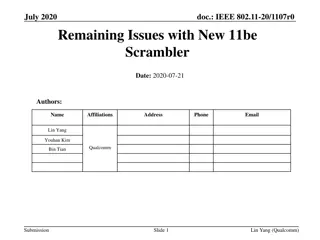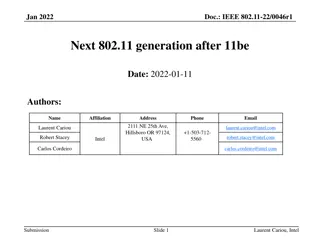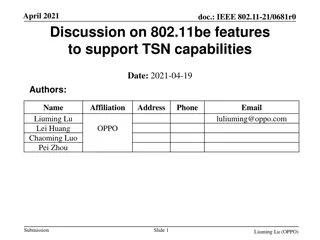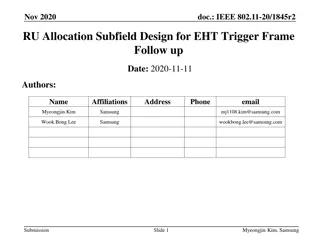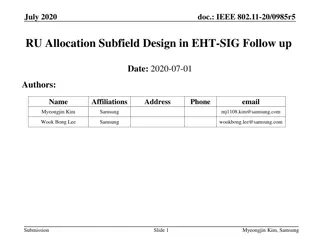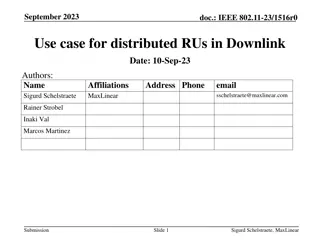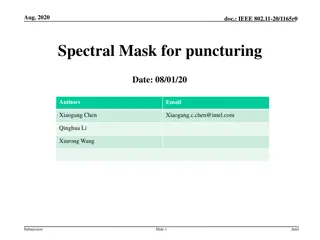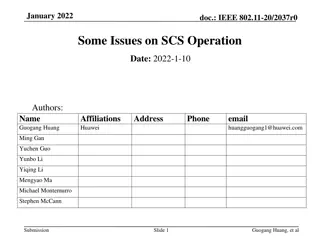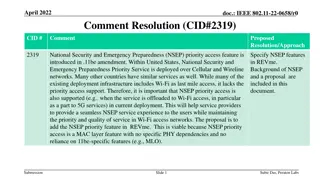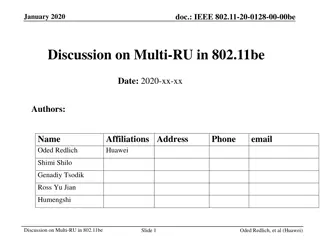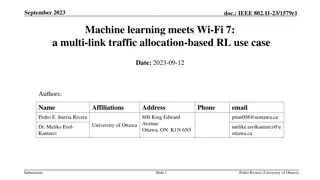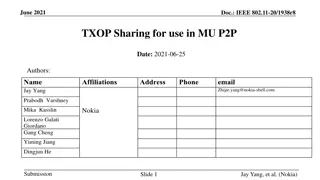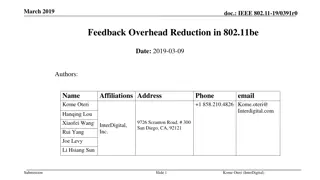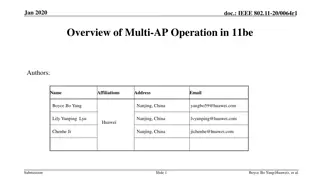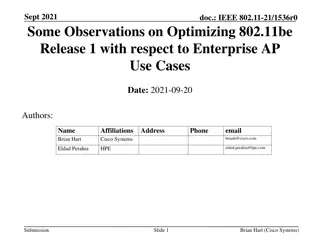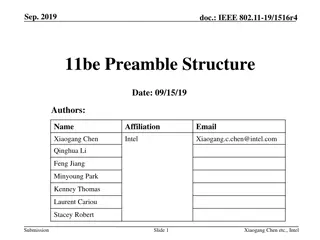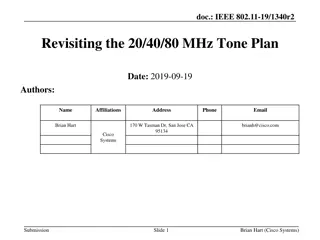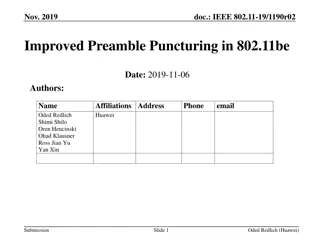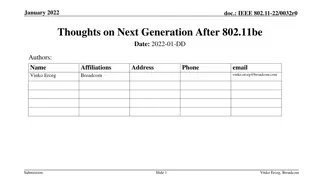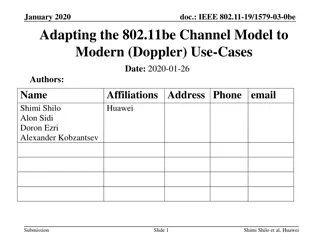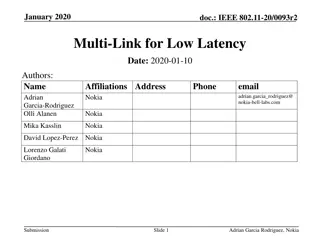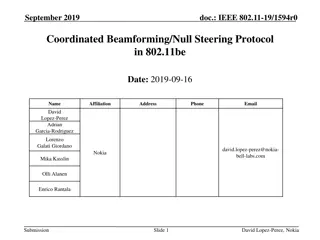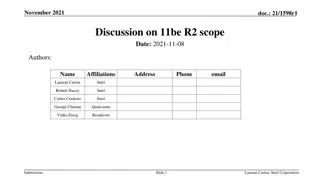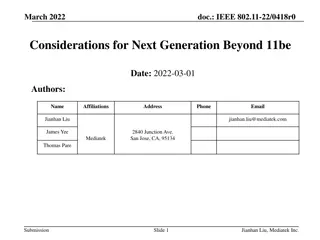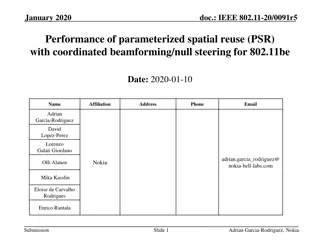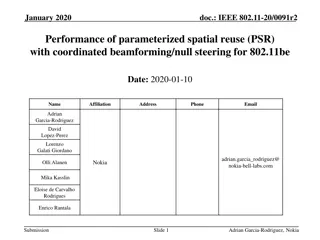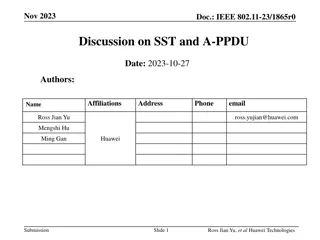Proposal for Random Access Efficiency Enhancement in IEEE 802.11be Networks
This document presents a proposal for enhancing random access efficiency in IEEE 802.11be networks through a Random-Access NFRP (RA-NFRP) principle. The proposal addresses the challenges of low efficiency in the current UORA procedure and introduces modifications based on the 802.11ax standard to im
5 views • 16 slides
Remaining Issues with New 11be Scrambler in IEEE 802.11-20
IEEE 802.11-20/1107r0 discusses the introduction of a new 11-bit scrambler in 11be to reduce payload PAPR. The document addresses issues related to the scrambler seed for CTS in response to MU-RTS transmissions, including the generation of PPDU synchronous scramblers, bit modulation in CTS and MU-RT
0 views • 7 slides
Evolution of Wi-Fi and Cellular Technologies for Next Generation
The document discusses the initiation of a new study group for the next generation of Wi-Fi following IEEE 802.11be, emphasizing objectives like deterministic operation, increased throughput, and capacity. It outlines a timeline for the launch of new mainstream PHY/MAC generations every four years.
6 views • 12 slides
Discussion on IEEE 802.11be Features for TSN Capabilities
IEEE 802.11be introduces features to support Time-Sensitive Networking (TSN) capabilities by enhancing throughput, traffic delivery paths, scheduling flexibility, and latency reduction. The standard addresses the stringent latency requirements of real-time applications, medium access protection, mul
1 views • 10 slides
Designing 9-Bit RU Allocation Subfield for EHT Trigger Frame in IEEE 802.11-20
IEEE 802.11-20/1845r2 presents a proposal for enhancing the RU allocation subfield design in the EHT Trigger frame to accommodate bandwidth support up to 320MHz and multiple RU or MRU allocations for UL MU transmissions in the 11be standard. The modification addresses inconsistencies in MRU mapping
0 views • 34 slides
IEEE 802.11-20/0985r5 RU Allocation Subfield Design in EHT-SIG
The document discusses the design of subfields in EHT-SIG for RU allocation in IEEE 802.11be, focusing on reducing overhead by considering supported large-size MRU combinations. It addresses concerns on entries overhead in the RU allocation subfield table and the clarity of support for specific MRU
3 views • 24 slides
Coordinated AP Time/Frequency Sharing in IEEE 802.11be
The document discusses Coordinated AP (CAP) Time/Frequency Sharing in Transmit Opportunity in IEEE 802.11be, focusing on Frequency and Time resource sharing between multiple APs in close proximity. It introduces concepts like CAP OFDMA and CAP TDMA, outlining the benefits in terms of latency improve
0 views • 15 slides
Use Case for Distributed Resource Units in Downlink Scenarios
The document explores the concept of distributed Resource Units (dRU) in downlink scenarios in IEEE 802.11 standards like 802.11ax and 802.11be. It discusses the benefits and potential advantages of using dRU in downlink transmissions, focusing on how it can effectively distribute tones across the s
3 views • 13 slides
Proposal for Reusing ETSI Puncturing Mask in IEEE 802.11be Standard
A proposal is presented in the document IEEE 802.11-20/1165r0 discussing the possibility of reusing the ETSI-defined puncturing mask in the context of the 11be standard. The document highlights the comprehensive nature of the ETSI mask, covering various puncturing cases, and suggests that adopting t
0 views • 12 slides
Discussion on IEEE 802.11be MLD Architecture Alignment
IEEE 802.11 TGbe is exploring MLDs within the 802 architecture, focusing on aligning MLD operations with existing 802.11 features for enhanced compatibility. The MLD architecture aims to facilitate the flow of data between MAC SAPs and PHY SAPs, extending the current framework for APs and non-AP STA
1 views • 23 slides
Issues with SCS Operation in IEEE 802.11be Standard
The document discusses technical issues related to the SCS (Spatial Channel Sharing) operation in the IEEE 802.11be standard. It highlights inconsistencies in the standard regarding parameterized QoS requirements, mixing of traffic streams with different QoS needs, and challenges in prioritizing SCS
0 views • 15 slides
Proposal to Add National Security and Emergency Preparedness Priority Access Feature in IEEE 802.11be Amendment
The document proposes integrating the National Security and Emergency Preparedness (NSEP) priority access feature into the IEEE 802.11be standard to ensure seamless NSEP service experience, particularly in Wi-Fi networks used as last-mile access. The NSEP priority feature at the MAC layer is indepen
0 views • 12 slides
Discussion on Multi-RU Allocation in IEEE 802.11be Standard
In January 2020, a discussion took place on the allocation of multiple Resource Units (RUs) to a single Station (STA) in the IEEE 802.11be standard. The proposal suggested categorizing RUs into small and large types, avoiding aggregation across multiple 20MHz channels. It emphasized assigning a sing
2 views • 29 slides
Spectrum Mask Requirements in IEEE 802.11 for Punctured Transmission
The document discusses the spectrum mask requirements for punctured transmission in IEEE 802.11 standards, specifically focusing on differences between ETSI and IEEE 802.11ax spectral masks. It covers cases of puncturing scenarios and additional channel edge masks to be applied in different situatio
1 views • 16 slides
Machine Learning Meets Wi-Fi 7: Multi-Link Traffic Allocation-Based RL Use Case
The paper discusses the application of a Reinforcement Learning algorithm, Multi-Headed Recurrent Soft-Actor Critic, for optimizing traffic allocation in IEEE 802.11be Multi-Link Operation networks. This work aims to enhance throughput and reduce latency in MLO-capable devices by distributing incomi
0 views • 18 slides
IEEE 802.11-2020 Multi-Link Reference Model Discussion
This contribution discusses the reference model to support multi-link operation in IEEE 802.11be and proposes architecture reference models to support multi-link devices. It covers aspects such as baseline architecture reference models, logical entities in different layers, Multi-Link Device (MLD) f
1 views • 19 slides
IEEE 802.11-20/1938r8 TXOP Sharing for MU P2P Communication
The document discusses the IEEE 802.11-20/1938r8 standard and proposes mechanisms for an Access Point (AP) to facilitate peer-to-peer communication between stations (STAs). It introduces the concept of triggered TXOP sharing to enhance latency performance and spectral efficiency in scenarios involvi
8 views • 8 slides
IEEE 802.11-20/0021-00 Priority Access Support for NS/EP Services Overview
This document discusses the importance of priority access support in IEEE 802.11be for National Security and Emergency Preparedness (NS/EP) services. It outlines the need for standardized mechanisms to ensure priority services in WLAN networks during NS/EP events when cellular coverage is unavailabl
1 views • 15 slides
Reduction of Feedback Overhead in IEEE 802.11be
Discussion on reducing channel acquisition overhead to support 16 Spatial Stream MIMO and Multi-AP coordination in IEEE 802.11be. Methods include limiting feedback information, using implicit feedback in reciprocal systems, and improving explicit and implicit feedback schemes.
0 views • 14 slides
IEEE 802.11-23/1980r1 Coordinated AP-assisted Medium Synchronization Recovery
This document from December 2023 discusses medium synchronization recovery leveraging multi-AP coordination for multi-link devices. It covers features such as Multi-link device (MLD), Multi-link operation (MLO), and Ultra High Reliability (UHR) capability defined in P802.11bn for improvements in rat
0 views • 8 slides
Understanding Multi-Band Multi-Channel Concept in IEEE 802.11be
Exploring the benefits of Multi-Band Multi-Channel (MBMC) operation in IEEE 802.11be, this study delves into the efficient use of spectrum, increased data rates, and network load balancing. It also discusses the envisioned usage models and compares Single Band Operation with Multi-Band Operation, hi
1 views • 20 slides
Overview of Multi-AP Operation in IEEE 802.11be
The document discusses the unique feature of multi-AP operation in IEEE 802.11be, emphasizing the performance benefits in various deployments. It addresses the need for AP-to-AP communication, the concept of anchor APs, interfaces for inter-AP communication, and backhaul options. The importance of f
0 views • 13 slides
Coordinated AP Time/Frequency Sharing in IEEE 802.11be
The document discusses the concept of Coordinated AP (CAP) Time/Frequency Sharing within a Transmit Opportunity (TXOP) in the IEEE 802.11be standard. It explains the procedures of Frequency and Time resource sharing, highlighting the benefits such as latency improvement and throughput fairness. Deta
0 views • 16 slides
Observing Optimization of IEEE 802.11be Release 1 for Enterprise AP Use Cases
IEEE 802.11be is being optimized for enterprise use cases due to existing features that can be enhanced. The focus is on educating about enterprise Wi-Fi operations and increasing awareness within the wider community. Various enterprise use cases such as call centers, events, hospitals, and office d
0 views • 13 slides
IEEE 802.11-19/1516r4: 11be Preamble Structure Overview
The document discusses the design and structure of the 11be preamble in IEEE 802.11-19/1516r4. It emphasizes reusing existing functions from previous WiFi generations and focusing on features that enhance user experience. The preamble includes elements such as Pre-EHT preamble, EHT preamble, legacy
0 views • 13 slides
Understanding Multi-Band, Multi-Channel Concept in IEEE 802.11be
Explore the advantages of Multi-Band, Multi-Channel (MBMC) operation in IEEE 802.11be, focusing on efficient spectrum use, increased data rates, and dynamic band switching. Learn about usage models and compare with single-band operations. Discover how MBMC enables concurrent operation across multipl
0 views • 22 slides
IEEE 802.11be MLD Architecture Discussion
The document discusses the architecture of MLD (Multicast and Local Delivery) within the IEEE 802.11be framework. It highlights how MLD will align with existing 802.11 basic architecture, emphasizing the management of access to PHY and media for both AP and non-AP devices. The goal is to integrate M
0 views • 9 slides
Time-Aware Scheduling Capabilities in IEEE 802.11be
Describing necessary enhancements to enable Time-Aware Scheduling in IEEE 802.11be for time-sensitive applications. The focus is on aligning with the 802.1Qbv standard to address latency, jitter, and reliability issues, presenting a structured outline of requirements and configurations essential for
0 views • 24 slides
Revisiting the IEEE 802.11-19/1340r2 Tone Plan Optimization
Revisiting the tone plan optimization for IEEE 802.11-19/1340r2, addressing issues with RUs near band edges, accommodating various STA bandwidth capabilities, and the inefficiencies of non-SST 11ax STAs in different BSS scenarios. Proposals include adapting to unknown future 11ax features, minimizin
5 views • 12 slides
Wireless TSN in 802.11: New Requirements and Integration with 802.1
This document discusses the extension of TSN capabilities from wired to wireless networks, focusing on potential enhancements for 802.11be and integration with Ethernet-based TSN standards. It covers topics such as time-sensitive applications, TSN toolbox overview, status of TSN capabilities support
4 views • 12 slides
Improved Preamble Puncturing in IEEE 802.11be Standard
The document discusses enhancements in preamble puncturing for the IEEE 802.11be standard, focusing on improving channel utilization in various network scenarios within a 160MHz bandwidth. It introduces improvements for multi-user and single-user PPDU scenarios to maximize available bandwidth and en
0 views • 11 slides
Insights on Future Wireless Standards Development
Delve into the progression of IEEE 802.11 standards with a focus on the transition from 802.11be to the next generation. Discussions revolve around the evolution of PHY/MAC task groups, motivations for the new generation, and potential enhancements in system efficiency, latency, throughput, and spec
0 views • 8 slides
Adapting the 802.11be Channel Model for Modern Doppler Use-Cases
The document discusses the adaptation of the 802.11be channel model to modern scenarios where devices are mobile. It explores the impact of movement on channel models, providing lab measurement results of Doppler Power Spectral Density. The study aims to enhance the evaluation of communication schem
0 views • 16 slides
Enhancing Efficiency and Latency Reduction in IEEE 802.11be Through Multi-Link Operation
Targeted at improving multi-link and low-latency capabilities in IEEE 802.11be, this document proposes a mode of operation utilizing multiple links to decrease latency effectively. By addressing channel access delay reduction and discussing the benefits of multi-link definitions, the document emphas
0 views • 17 slides
Coordinated Beamforming/Null Steering Protocol in IEEE 802.11be
Coordinated beamforming/null steering is a promising scheme in IEEE 802.11be for joint transmission/reception challenges. This protocol aims to efficiently realize gains by establishing semi-static inter-AP coordination, enhancing spatial reuse opportunities, implementing CSI acquisition, and managi
0 views • 15 slides
Discussion on 11be R2 Scope and Main Solution
The document from November 2021 discusses the scope of the 11be R2 release, highlighting the need to keep the scope small to effectively manage features. The timeline, target milestones, and challenges in defining features for the second release are outlined. The main solution proposed involves movi
0 views • 6 slides
Considerations for Next Generation Wi-Fi Features Beyond IEEE 802.11be
The document discusses considerations and metrics for the next generation of Wi-Fi beyond IEEE 802.11be, focusing on performance metrics, latency reduction for gaming and interactive video, range extension for wireless video doorbells and surveillance, and market needs for various applications like
0 views • 11 slides
Performance Evaluation of Parameterized Spatial Reuse with Coordinated Beamforming for IEEE 802.11be
The study focuses on assessing the performance of parameterized spatial reuse (PSR) with coordinated beamforming/null steering for IEEE 802.11be. The framework allows coordinated sharing of uplink transmission opportunities among APs, demonstrating gains in synchronous coordinated beamforming system
0 views • 19 slides
Performance Evaluation of Coordinated Beamforming with Parameterized Spatial Reuse in IEEE 802.11be
The document discusses the performance evaluation of coordinated beamforming with parameterized spatial reuse (PSR) in IEEE 802.11be. It explores the practical operation of the 802.11ax PSR framework with null steering and the key implementation benefits, emphasizing unsynchronized operation and ada
0 views • 20 slides
Discussion on IEEE 802.11-23/1865r0: SST and A-PPDU
The document discusses the current lack of support for SST on S160 in 11be, highlighting that 11be AP and STA do not support A-PPDU. It explores potential combinations for A-PPDU involving UHR and non-UHR HE and EHT STAs, addressing bandwidth enhancements and benefits of various scenarios. The analy
0 views • 14 slides

